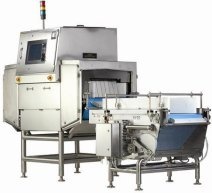 For any packaged food manufacturer, product safety is of the utmost concern. When products are unsafe, they can create a public relations nightmare that can be difficult for any company to recover from.
For any packaged food manufacturer, product safety is of the utmost concern. When products are unsafe, they can create a public relations nightmare that can be difficult for any company to recover from.
Customer trust takes a long time to build, but only seconds to lose. Because of this simple fact, many businesses invest heavily in making sure that their products are safe.
From adding manual product inspection stations and workers, to carefully vetting ingredient sources, to running HACCP-compliant hazard analyses, food makers do a lot to ensure product safety.
Another measure that many food companies have successfully used to enhance product safety is x-ray product inspection technology. This technology uses an x-ray emitter to quickly scan a product for signs of foreign bodies that could be harmful to consumers.
For years, x-ray inspection has been a key ingredient to a safe packaged food manufacturing process for companies all over the world. How does this technology make for safer products in the food industry?
Here are a few ways that x-ray inspection helps make food safer:
1: Foreign Body Detection
The most basic, and some might say important, function of an x-ray product inspection machine is to check products for signs of foreign bodies that could be harmful to consumers.
When a product or package is passed through an x-ray inspection machine, the x-ray emitter emits a low-level burst of electromagnetic waves in the x-ray spectrum. These waves pass through the package being inspected and onto a special receiver.
As the x-rays pass through objects, some of them will be absorbed or deflected by the masses that they pass through. The inspection machine interprets the rate at which x-rays pass through products to create a grayscale image of the product.
The image is compared to a previously-established acceptance standard, and if a denser contaminant is present, the product will be rejected and the contaminant will be highlighted in the image for future reference.
This process helps make sure that contaminated products don’t get sent out the door. Example of detectable contaminants are:
- Metals: Ferrous, Non-Ferrous and Stainless Steel
- Glass
- Stone
- Bone
- High Density Plastic and Rubber
- Etc.
2: Non-Invasive Inspection of Products
One of the best benefits of using x-ray product inspection is that it allows for the inspection of already-sealed packages at the end of the production line without having to compromise product seals.
For example, say that your company sold jars of peanut butter and during the sealing phase, there was a risk of dense plastic shards or rubber chunks being introduced to the jar’s contents. Without x-ray inspection, it would be difficult to check the inside of the jar for nonmetal contaminants without breaking the seal.
With x-ray inspection, particularly with material discrimination x-ray (MDX) enabled machines, spotting such nonmetal contaminants inside of a sealed jar is easy.
Because x-ray product inspection machines can check a package’s contents without having to disturb the package’s seals, x-ray inspection can be an effective last line of defense against product contamination before products are sent out for shipping.
It is important to note, however, that some packaging materials can interfere with an x-ray analysis.
3: Quality Defect Inspection
Another benefit of x-ray inspection for product safety is that it can be used to check and detect a multitude of product quality defects such as:
- Bad weight or incorrect level fill
- Missing cap or components
- Incorrect dimensions or count
- Incorrect seal
- Fat to Lean Ration (or Chemical Lean), moisture, protein level
- Etc.
These are just a few of the ways that x-ray product inspection can be integral for food safety.




